Indulge in the delight of Beef Chow Fun, a beloved stir-fry among Cantonese food enthusiasts. Picture this: tender beef, fresh rice noodles, vibrant green onions, crisp bean sprouts, all dancing together in a wok with a touch of dark soy sauce. A culinary masterpiece often found in the repertoire of top-notch Chinese restaurants, not your everyday buffets. Savor the flavors that make every bite an experience!
This post does contain affiliate links that do earn the site a commission. These commissions help to support the site.
Beef Chow Fun Ingredients:
Beef: For a Beef Chow Fun recipe, it’s ideal to use thinly sliced flank steak. The thin slices of flank steak work well with the quick cooking time involved in stir-frying and contribute to the tender and succulent texture of the dish. Flank steak is a lean cut with a good balance of flavor, and its thin slices absorb the savory sauce, enhancing the overall taste of the Beef Chow Fun.
Rice wine: The alcohol content in rice wine helps to break down the protein fibers in the meat, contributing to the tenderness of the beef. This is especially important when working with cuts that may be less naturally tender.
Soy sauce is rich in umami, a savory taste, which enhances the overall flavor of the beef. It adds depth and complexity, making the dish more enjoyable.
Dark soy sauce imparts a rich, deep brown color to the beef and noodles, enhancing the visual appeal of the dish. This contributes to the characteristic dark and glossy appearance that is often associated with Beef Chow Fun.
Cornstarch acts as a tenderizer for the beef slices. When incorporated into the marinade, it helps break down the proteins in the meat, resulting in a more tender and succulent texture after cooking.
Peanut oil has a high smoke point, making it suitable for the high-heat cooking involved in stir-frying. It can withstand the intense temperatures needed to achieve the characteristic flavors and textures in Beef Chow Fun without breaking down or imparting a burnt taste.
Oyster sauce has a thick and syrupy consistency, which serves as a natural thickening agent for the stir-fry sauce. It helps create a glossy and slightly thickened sauce that coats the beef and noodles, enhancing their overall texture.
Sesame oil is often used as a finishing oil in stir-fry dishes, including Beef Chow Fun. Drizzling a small amount of sesame oil just before serving enhances the flavors and provides a final touch of richness.
White pepper provides a milder heat compared to black pepper. It adds a subtle spiciness to the dish without overpowering the other flavors, allowing the natural taste of the beef and other ingredients to shine.
Fresh garlic provides a robust and pungent flavor to the dish. Its aromatic and distinctive taste enhances the overall savory profile of the stir-fry.
White onions have a milder and sweeter flavor compared to yellow or red onions. This allows them to enhance the overall taste of the Beef Chow Fun without overpowering the dish.
Rice noodles: For Beef Chow Fun, wide flat rice noodles are traditionally used. These noodles are sometimes called ho fun, he fen, or Shahe fen, depending on the regional dialect. They are made from rice flour and water, resulting in a soft and chewy texture.
Wide flat rice noodles are an essential component of Beef Chow Fun, contributing to the dish’s characteristic texture and flavor. These noodles are broad, flat, and have a slightly slippery quality, making them distinct from other types of noodles.
Green onions or scallions pair well with beef, complementing the meat’s savory profile. They add a layer of complexity to the stir-fry and contribute to a well-balanced flavor profile.
Bean sprouts add a crunchy texture to the dish, providing a pleasant contrast to the softer noodles and tender beef. This variety in texture enhances the overall mouthfeel of the stir-fry.
Baking soda helps tenderize the beef by breaking down its proteins. This results in a more tender and succulent texture, especially in cuts of meat that might be less naturally tender.
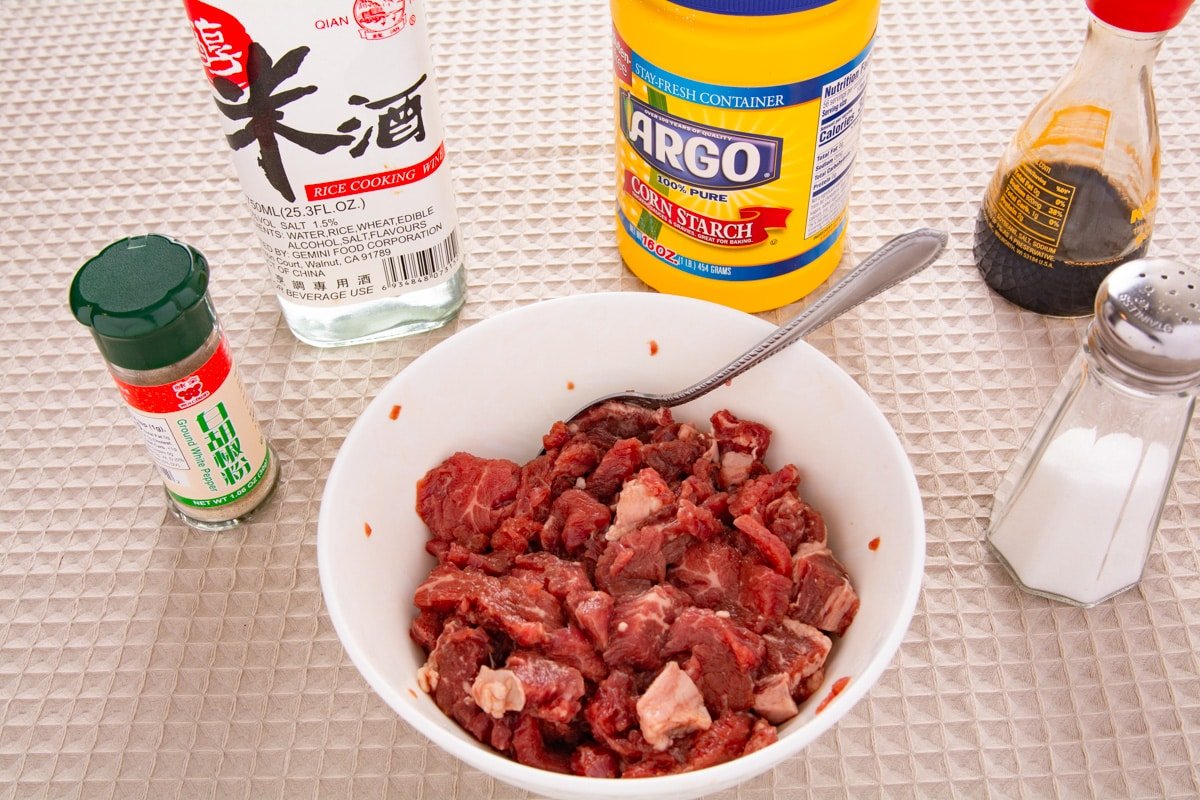
Velvet your beef
In Chinese cooking, velveting refers to a cooking technique used to prepare meat, particularly poultry or seafood, for stir-frying. The process involves marinating the meat in a mixture that usually includes egg white, cornstarch, and sometimes rice wine or soy sauce. The meat is then briefly blanched in hot water or oil before being stir-fried.
The purpose of velveting is to create a protective layer around the meat, resulting in a tender and velvety texture. The egg white and cornstarch mixture forms a coating that helps retain the moisture of the meat during the high heat of stir-frying. This technique is commonly used in Chinese restaurant cooking to achieve the signature tenderness and succulence in dishes like stir-fried chicken, beef, or shrimp.
We’re gearing up to marinate our beef, aiming for that delicious Chinese restaurant flavor without the need for deep frying. Here’s a little tip: for that extra tenderness, I’m opting for baking soda. While some go for it, be cautious – too much can turn your meat bitter.
I’ve got some thinly sliced flank steak in the mix. In a bowl, toss it with rice wine for a flavorful start. Pour in soy sauce and a pinch of salt, giving it a good stir. Make sure that cornstarch blends in smoothly, leaving no white specks behind. Now, the waiting game begins – let it sit for a minimum of 30 minutes. Get ready for a taste sensation!
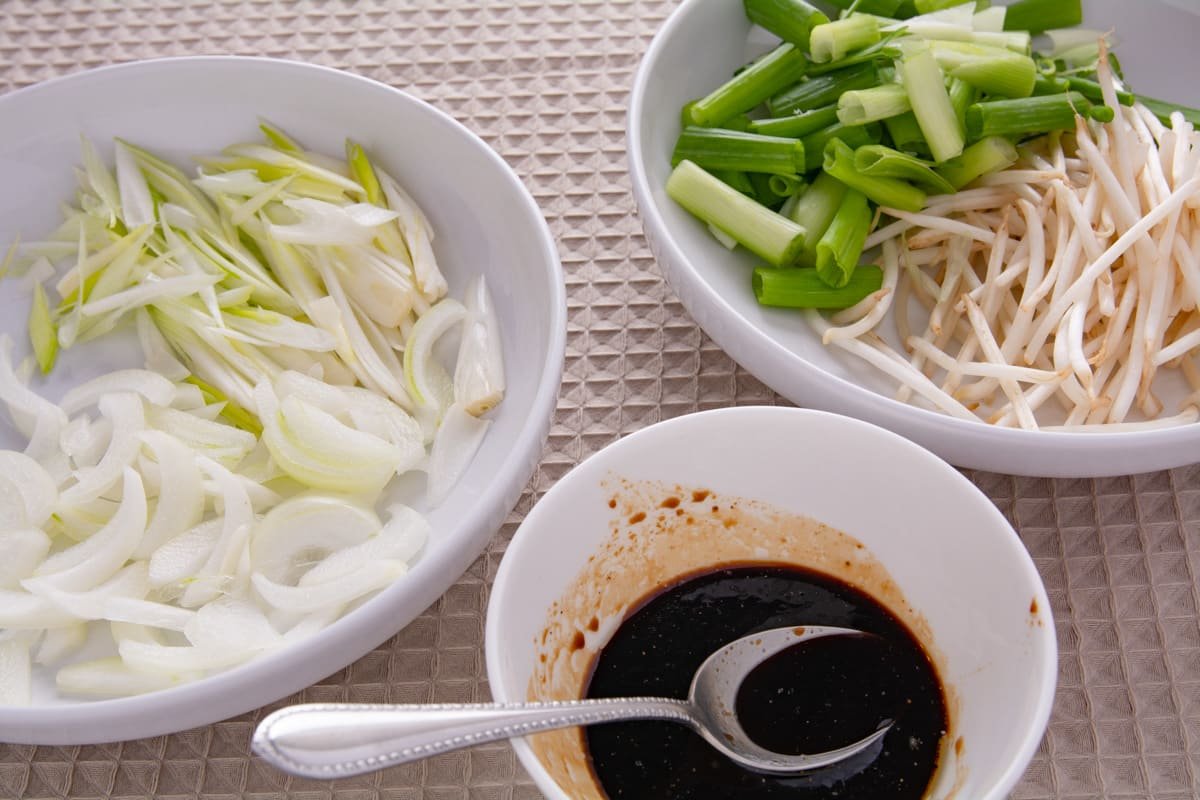
Now, let’s dive into crafting our delectable savory sauce. Gather oyster sauce, soy sauce, dark sauce, white pepper, and sesame oil in a small bowl. Give them a whirl, mix it all up, and set this flavor-packed concoction aside for the main event. Pro tip: keep the dark sauce sauce within arm’s reach of your cooking zone.
Next up, let’s prep those vibrant veggies: slice the onion thinly, give the garlic a rough chop, section the green onion, and don’t forget to separate the white from the green parts. For the bean sprouts, a good rinse and inspection are in order. If you’ve got soybean sprouts, bid farewell to the heads—they won’t be joining the party.
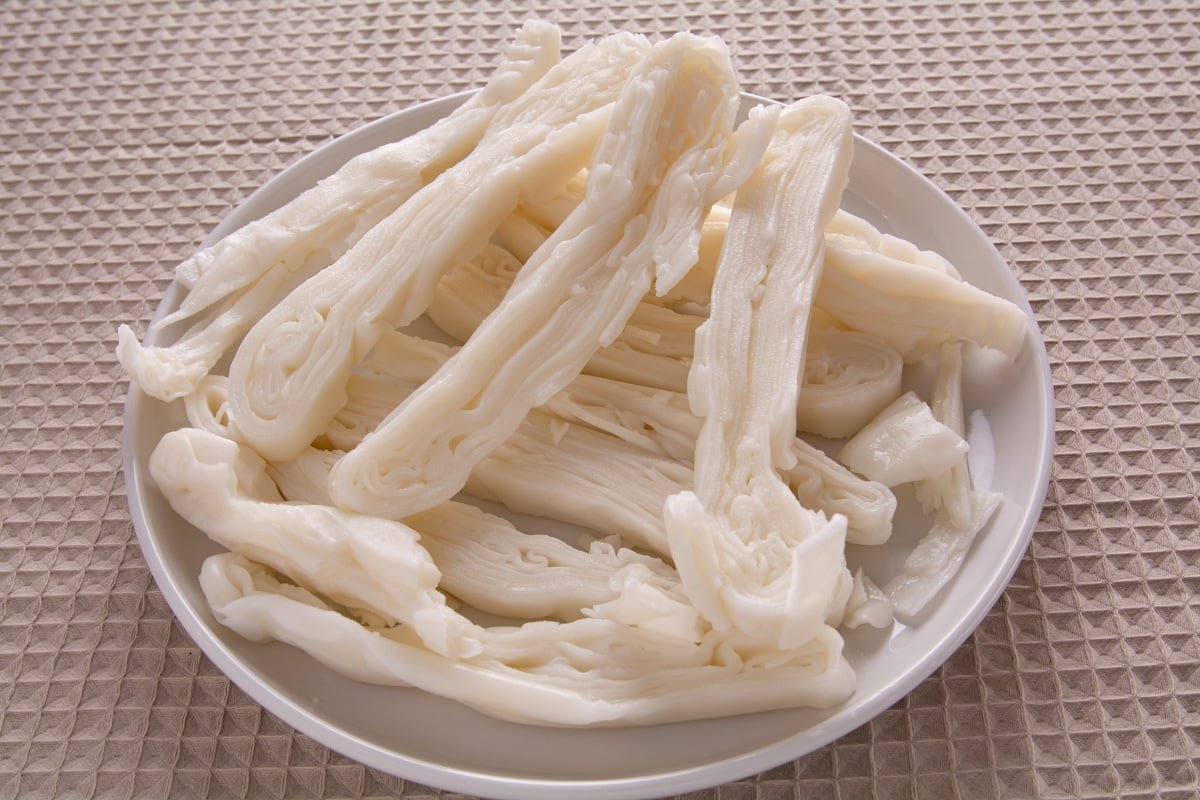
Let’s talk rice noodles prep, and it all hinges on whether they’re fresh or have taken on a bit of a hardened demeanor. Now, if you’ve struck gold and got your hands on fresh noodles, it’s a breeze – just liberate them from the package and give them a gentle separation. Easy peasy!
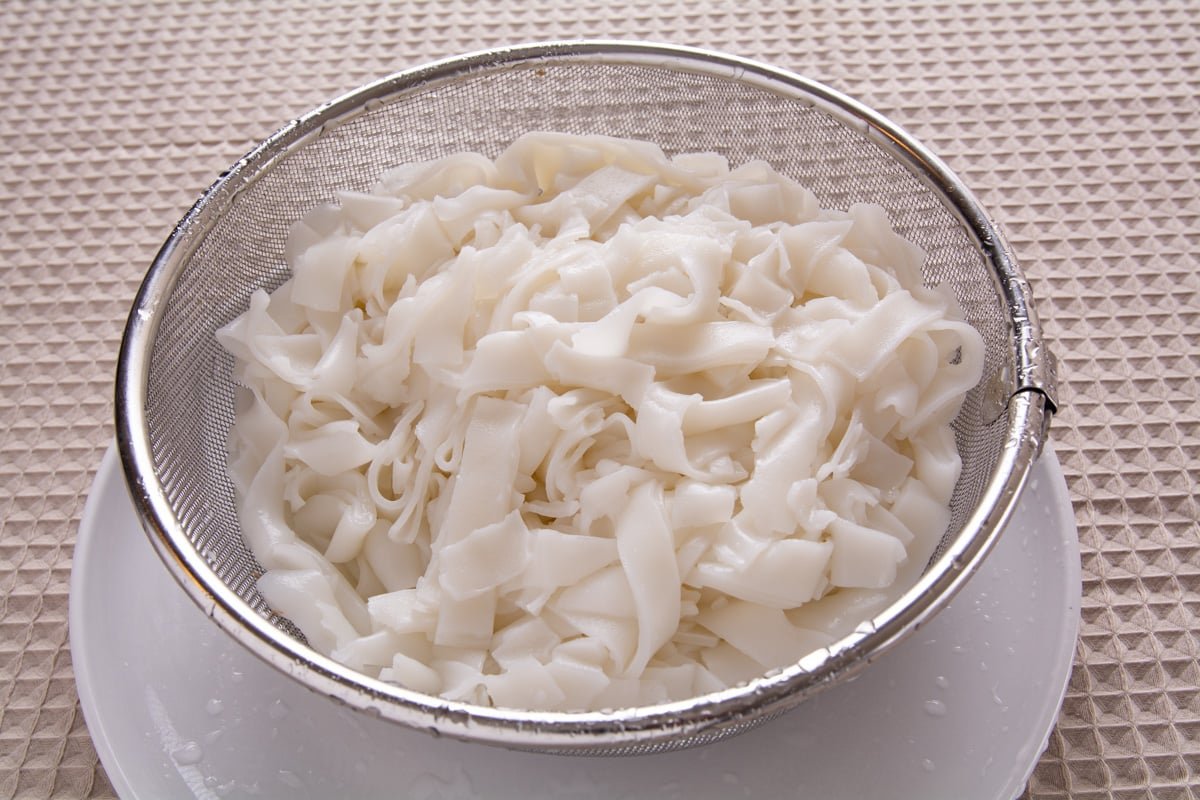
Let’s tackle those rice noodles! If they’re not quite as fresh, we’ll need to give them a little spa treatment before the stir-fry party. Boil some water, let it reach a happy bubble, then gracefully drop in those noodle sections. After a minute-long soak, work your magic with chopsticks or tongs, giving them some gentle separation.
Once they’re mostly free-spirited, guide them into a colander, shower them with cold water, and give them a once-over for any noodle clingers. A touch of oil, a gentle toss, and voilà – no sticking here!
Now, for the main act – the cooking stage. Whether you choose a large skillet or the trusty wok, it’s your call. I lean towards the wok, but hey, no pressure.
Heat things up by choosing your preferred oil – peanut oil is my go-to for that extra flair, but vegetable oil is a worthy sidekick. Crank up the heat, let the wok get smokin’ hot, then swirl in the oil, coating those wok walls like a pro.
Introduce your thinly sliced beef, let it stick for a bit (it’s just finding its groove), then flip and stir-fry until it’s almost there. A quick exit to a plate is key to avoid overcooking, thanks to the carry-over magic.
Give your wok a breather, maybe a quick wash if needed. Add more oil, and toss in onion, garlic, and the white part of the green onion. A swift stir sets the stage.
Here comes the noodle dance! Gently introduce the rice noodles, let them flirt with some color, and flip gracefully. A few rounds of this ballet and it’s sauce time – stir-fry sauce, you’re up! Toss, taste, and add more dark soy sauce if needed.
The grand finale: bring back the beef, toss in crunchy bean sprouts, and the green part of the green onion. One more minute of stir-frying, and ta-da! Your culinary masterpiece is ready to steal the spotlight. Enjoy the savory symphony!
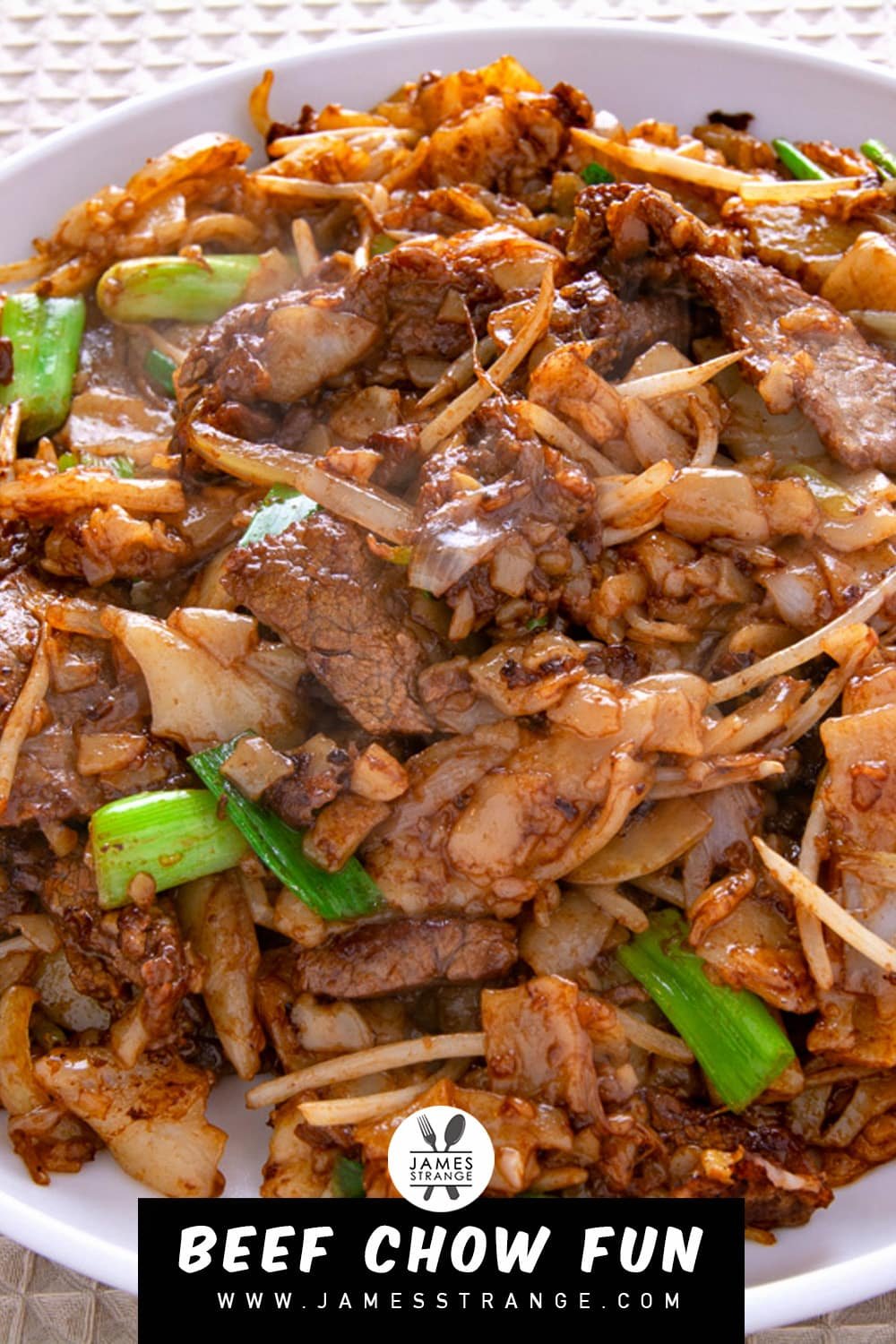
If you found this recipe delightful, why not share the goodness with your friends? Spread the joy of a tasty beef chow fun by sharing this recipe with your pals.

Ingredients
Beef
- 10 oz Beef
- 1 Tablespoon Rice wine
- 1 teaspoon soy sauce
- 1 teaspoon corn starch
- 1/2 Tablespoon Oil Peanut or corn
- 1 pinch salt
Sauce
- 1 Tablespoon Oyster Sauce
- 1 Tablespoon Soy Sauce
- 1/2 Tablespoon Dark Soy Sauce
- 1/2 teaspoon sesame oil
- 1/8 teaspoon white pepper
Veggies
- 1 Cup bean sprouts
- 1/4 each onion
- 4 each green onion
- 1 clove garlic
Noodles
- 1 pound Rice noodles
Other
- 1/2 Tablespoon Oil
- 2 Tablespoons oil Peanut or corn
- 1/2 Tablespoon sesame seeds For garnish
Instructions
Marinate Beef
- To thinly sliced beef add rice wine, soy sauce, salt, and corn starch. Give a good mix then add 1/2 Tablespoon of oil. Give another mix. Set aside until ready to cook.10 oz Beef, 1 Tablespoon Rice wine, 1 teaspoon soy sauce, 1 teaspoon corn starch, 1/2 Tablespoon Oil
Sauce
- To a small bowl add oyster sauce, soy sauce, white pepper, and dark soy sauce1 Tablespoon Oyster Sauce, 1 Tablespoon Soy Sauce, 1/2 Tablespoon Dark Soy Sauce
Prepare Veggies
- Wash and inspect bean sprouts. If using soybeans remove the heads.1 Cup bean sprouts
- Slice the onion1/4 each onion
- Cut up the green onion. Separate the white from the green part.4 each green onion
- Roughly chop the garlic.1 clove garlic
Prepare the noodles
- Bring a pot of water to boil. Add the noodles and turn off the heat.1 pound Rice noodles
- Gently separate the noodles. Pour the noodles into a colander.
- Rinse with cold water then add 1/2 Tablespoon of oil and toss.1/2 Tablespoon Oil
Stir-Fry
- With the wok on high heat add one Tablespoon of oil. Give a swirl to coat the wok.2 Tablespoons oil
- Add the beef and gently spread out. Give it a few seconds to sear then flip.10 oz Beef
- Give it a few seconds to sear then start to stir fry.
- After the beef has lost most of its color remove it from the wok and set it aside.
- Add one tablespoon of oil to the wok then add the onion, garlic, and white part of the green onion. Give it a stir.1/4 each onion, 1 clove garlic, 4 each green onion
- Add the rice noodles. Gently stirfry them on high heat.1 pound Rice noodles
- After the noodles start to get some color then add the sauce and gently stir it in.
- Return the beef to the wok, and add the bean sprouts and green onion.10 oz Beef, 1 Cup bean sprouts, 4 each green onion
- Stirfry for one minute then serve.

I really loved this recipe! The beef was super flavorful and even my veggie hating husband, had seconds! I’m making this again soon!
That’s awesome glad he enjoyed the veggies
SO yummy! I had a flank steak in the freezer and was hungry for some good Chinese food. This recipe did not disappoint! My husband raved about it, too!
So glad you liked the recipe